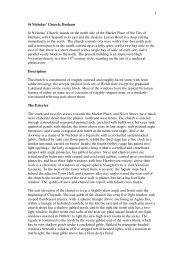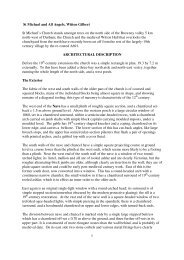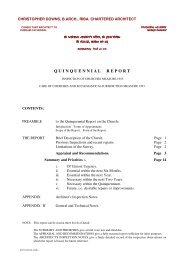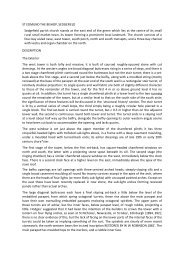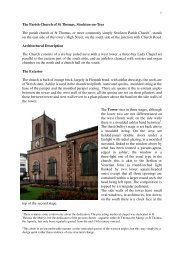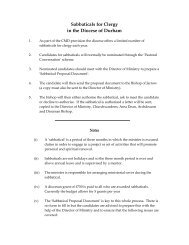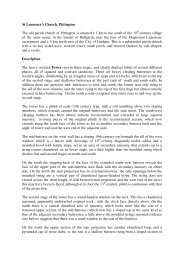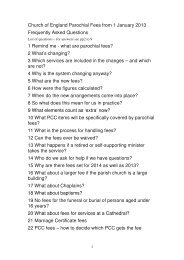1 St Peter's Church, Elwick Hall St Peter's, the parish church of ...
1 St Peter's Church, Elwick Hall St Peter's, the parish church of ...
1 St Peter's Church, Elwick Hall St Peter's, the parish church of ...
You also want an ePaper? Increase the reach of your titles
YUMPU automatically turns print PDFs into web optimized ePapers that Google loves.
636617.4.1986Setting <strong>of</strong> a sun-dial above keystone <strong>of</strong> main<br />
entrance to <strong>church</strong>.<br />
THE STRUCTURAL HISTORY OF THE CHURCH<br />
The evidence <strong>of</strong> <strong>the</strong> two grave markers implies a Pre-Conquest<br />
<strong>church</strong> on or near <strong>the</strong> site; ano<strong>the</strong>r possible piece <strong>of</strong> evidence<br />
already mentioned is <strong>the</strong> gritstone dressings <strong>of</strong> <strong>the</strong> small<br />
blocked window in <strong>the</strong> south aisle wall immediately west <strong>of</strong> <strong>the</strong><br />
tower.<br />
The earliest architectural feature <strong>of</strong> <strong>the</strong> present <strong>church</strong> is <strong>of</strong><br />
late 12th century date (Reynolds suggest 1180-1190);<br />
contemporary with this may be <strong>the</strong> well-squared masonry <strong>of</strong> <strong>the</strong><br />
west end <strong>of</strong> <strong>the</strong> nave and <strong>the</strong> lower parts <strong>of</strong> <strong>the</strong> chancel. The<br />
core <strong>of</strong> <strong>the</strong> nave walls may conceivably be earlier; evidence for<br />
this hinges on <strong>the</strong> form <strong>of</strong> <strong>the</strong> chancel arch preceding <strong>the</strong> preset<br />
19th-century one. Reynolds (op.cit.181) suggests that a larger<br />
and later chancel arch (<strong>of</strong> which he identified a stone lying in<br />
<strong>the</strong> <strong>church</strong>yard, now lost, as one <strong>of</strong> <strong>the</strong> capitals) had been built<br />
up, and a smaller round-headed opening (perhaps post-medieval)<br />
inserted in <strong>the</strong> blocking; in a footnote to his article<br />
(ibid.182) <strong>the</strong> Rev J.F.Hodgson queries this and suggests that<br />
<strong>the</strong> round-headed arch was an genuine earlier-12th century<br />
feature, like that at Haughton-le-Skerne.<br />
The south arcade is stylistically a little later than <strong>the</strong> north;<br />
Hodgson suggested a date <strong>of</strong> c1220; <strong>the</strong> aisle wall is presumably<br />
<strong>of</strong> <strong>the</strong> same date. However, it has several unusual features; in<br />
addition to <strong>the</strong> strange little window with gritstone dressings,<br />
it is unusually thick, and <strong>the</strong> position <strong>of</strong> <strong>the</strong> south door seems<br />
quite unrelated to <strong>the</strong> arcade; all <strong>of</strong> this could point to its<br />
surviving from an earlier phase <strong>of</strong> <strong>the</strong> building.<br />
O<strong>the</strong>r medieval features that survive are not closely dateable.<br />
The blocked window in <strong>the</strong> south wall <strong>of</strong> <strong>the</strong> chancel which cuts<br />
<strong>the</strong> late-12th century string course may be a 13th-century<br />
lancet; west <strong>of</strong> this a priest's door seems to have been reduced<br />
to a low-side window, possibly at <strong>the</strong> same time. The lower part<br />
<strong>of</strong> <strong>the</strong> tower is also medieval, although heavily remodelled; <strong>the</strong><br />
early-19th century print <strong>of</strong> <strong>the</strong> <strong>church</strong>, which seems to show it<br />
before <strong>the</strong> 1812 alterations, shows <strong>the</strong> tower with diagonal<br />
buttresses to its lowest stage, which would suggest a 14th or<br />
15th century date. There are 15th century porch towers in this<br />
position at Danby and Hutton Rudby, both in Cleveland, and a<br />
14th-century example set at <strong>the</strong> west end <strong>of</strong> a shortened south<br />
aisle at Cr<strong>of</strong>t-on-Tees.<br />
10




